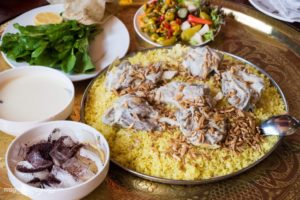This is a response to Task 5 of the community interaction prompts. I absolutely love cooking and am passionate about food and its relation to culture and history so I will try not to ramble in this post! The “national dish” of Jordan is mansaf, one of my favorite foods ever. The word mansaf in Arabic literally means (in some contexts) a large serving tray. Mansaf is made from placing bread on the bottom of a tray, topping it with rice, and then topping that with lamb cooked in a yogurt sauce called jameed.
You can find this dish in restaurants although it is best eaten at home, especially for a big celebration. So I did not go to a restaurant to talk about the food but instead have talked about it countless times with families who are preparing it – in the Arab world, the best food is always in homes. Mansaf has been a traditional food of the Arab bedouins of the Arabian Peninsula for a very long time. Although it is considered the national dish of Jordan, some bedouins still eat it in Saudi Arabia as well. You can see the bedouin history in the dish especially in the yogurt, called jameed. Jameed is a goats milk yogurt that is dried and preserved in hard balls. This way the yogurt keeps and does not require refrigeration. The jameed is then soaked and cooked and it turns into a delicious, almost tangy and very rich yogurt. Typically, the bedouin would have served mansaf for a huge celebration like a wedding, in which they would have slaughtered a lamb or a goat as a way of showing gratitude and appreciation and so forth. The lamb is cooked in a rich broth with spices like cinnamon and bay leaf until it is tender. Then, some of this broth is used to flavor the jameed and the lamb is then put with the jameed to incorporate a bit. Some cooks make their rice with turmeric which adds to the presentation because of the beautiful yellow it turns the rice, but not everyone does this. Often, before eating, the host/cook will give you a small glass of the jameed to drink.
The “authentic” way to eat mansaf is with your hands. This practice is common in the Arab region, and has its roots in the sparse water supply, especially for the bedouin. If there is not a lot of water, you certainly don;’t want to have to worry about washing forks and spoons, when you can just wash your hand instead.
Mansaf was quickly adopted as a “national dish” after the formation of Jordan as a state in the mid-twentieth century, and although it is loved by everyone, there is a friendly, spirited debate among Jordanians about what dish is better: mansaf or msakkhan. Msakkhan is a Palestinian dish of chicken and onions cooked until soft and caramelized with tons and tons of sumac, a lemony, bright spice, and served over bread. Because there are so many Palestinians in Jordan, it is often debated in a friendly way which “team” you’re on as to which dish is better – mansaf or msakkhan.
In the end, both dishes reveal a lot about Jordanian culture and history. Mansaf reflects the dynamic bedouin tradition still alive and well in Jordan, and msakkahn reflects modern political realities of the Middle East since the second world war, when huge amounts of Palestinians were forced to come to Jordan to live.
